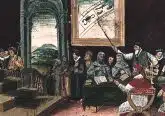Military Records Turn the Notch Up on Research

As we continue our genealogical research, military records provide rich information for ancestors who registered for the draft or served, sometimes identifying dependents. A federal website offers this information free, though other sources can supplement our efforts.
The National Archives and Records Administration (NARA) houses documents and materials created by the United States federal government and holds in trust citizen’s public records, including military and naturalization records.
In a democracy, government records belong to the people, helping citizens claim their rights and entitlements, holding elected officials accountable for their actions and documenting history as a nation.
NARA is the premier free website to begin researching military records, at https://www.archives.gov/research/military. Under the “Research by War or Conflict” section, it lists periods from the American Revolutionary War (1775-1783) to the Vietnam War (1961-1975). =And the site’s “Research by Topic” section enables research by: Military Personnel Records, Historical Military Records, Cold War and Interwar Period and Office of Strategic Services (OSS) and Intelligence Records.
HOW DO MILITARY RECORDS HELP IN GENEALOGY RESEARCH?
Compiled Service Records provide the enlisted person’s rank, unit, dates mustered in and mustered out and basic biographical, medical and military information.
Pension Applications and Payment Records for veterans, their widows and other heirs are based on service in the
armed forces between 1755 and 1916. Contents often include narratives of events during service, marriage certificates, birth records, death certificates, pages from family Bibles and family letters.
Bounty Land warrant application files relate to claims based on wartime service between 1775 and March 3, 1855. Ancestors who served in the Revolutionary War, War of 1812, early Indian Wars or the Mexican War may have these files, which contain substantial genealogical information. Note that some earlier bounty land application files are included in the pension files.
HOW TO BEGIN SEARCHING MILITARY RECORDS?
First, visit “An Overview of Records at the National Archives Relating to Military Service” at: https://archives.gov/ publications/prologue/2002/fall/military-records-overview. html. Determine the best search paths with these questions: In which military branch did the person serve? In what conflict did your ancestor fight, and what were the dates of service? Was service with the regular Army or a volunteer unit? Did your ancestor apply for or receive a pension?
Then, visit https://archives.gov/research/genealogy and start with genealogy resources, charts, forms and NARA genealogy videos (via YouTube). Expand your research with the site’s other resources, such as tools for genealogists, census records, military service records and immigration and naturalization records.
Selective Service Records: In 1863, during the Civil War, Congress passed the first military conscription act, allowing President Abraham Lincoln to draft men between the ages of 20-45. The second military draft law, the Selective Service Act, went into effect in 1917, authorizing President Woodrow Wilson to conscript men for World War I. In 1940, President Franklin D. Roosevelt signed the Selective Training and Service Act, creating the country’s first peacetime draft and officially establishing the Selective Service System. The draft continued during peacetime and war until 1973, when President Richard M. Nixon signed legislation officially ending the draft; made effective in 1975. However, President James E. Carter resumed Selective Service registration in 1980 in response to the Soviet invasion of Afghanistan.
Information on the “draft card” can be a great find! World War I (usually handwritten) and World War II draft registration cards include the person’s date of birth, residence, employment, ethnicity, race, physical description and emergency contact’s name and address—along with who the person supported (e.g. dependents). And, the draft cards include the veteran’s signature!
information can be found at FamilySearch (free) and through paid subscriptions at Ancestry.com and Fold3. com.
The Archdiocese of Cincinnati and the Archdiocese for the Military Services (AMS) also have connections to the military, including: priest ordinations, aid for military families and military priest-chaplains
MILITARY PERSONNEL INFORMATION
As a recent example, in May 2023, Father Stephen J. Hughes, a 2d Lt in the U.S. Air Force, was ordained as a Catholic priest in the Archdiocese of Cincinnati. Also, two Catholic
U.S. Military chaplains were ordained priests in Cincinnati on May 15, 2021: Father Michael Kapolka, 2d Lt, USAFR, and Father Edward Hoffmann, (1LT) IRR. Both hoped to serve as priests on active duty—the diocese released them in July 2024 for extended Active Duty as chaplains in the United States military.
We sincerely thank all veterans for their service!
NEXT UP: The importance of oral histories. As we gather for the holidays, let’s capture our family stories!
 Ruthy Trusler is a communication consultant with a passion for genealogy. For over 20 years, she has helped families document their ancestry and write their family legacies.
Ruthy Trusler is a communication consultant with a passion for genealogy. For over 20 years, she has helped families document their ancestry and write their family legacies.
This article appeared in the November 2024 edition of The Catholic Telegraph Magazine. For your complimentary subscription, click here.













